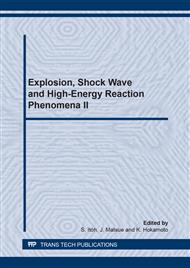p.144
p.150
p.154
p.160
p.166
p.171
p.177
p.183
p.188
Influence of Gap Length on Collision Angle and Collision Point Velocity of Magnetic Pressure Seam Welding
Abstract:
Magnetic pressure seam welding is a collision welding process, similar to explosive welding, utilizing electromagnetic force as the acceleration mechanism. True metallic bonding is achieved at the mating interface if contact takes place above an appropriate collision point velocity and collision angle. This paper deals with dynamic deformation process on magnetic pressure seam welding of aluminum sheets. Numerical analysis of the dynamic deformation process of the metal sheets is made by a finite element method. In this analysis, the metal sheets (100 mm width, 1 mm thickness) are assumed to be composed of plane-strain quadrilateral elements. The result shows that when the gap length becomes narrow, collision point velocity was decreased early. When the gap length becomes narrow, collision angle was increased slowly.
Info:
Periodical:
Pages:
166-170
Citation:
Online since:
July 2013
Authors:
Price:
Сopyright:
© 2014 Trans Tech Publications Ltd. All Rights Reserved
Share:
Citation:


